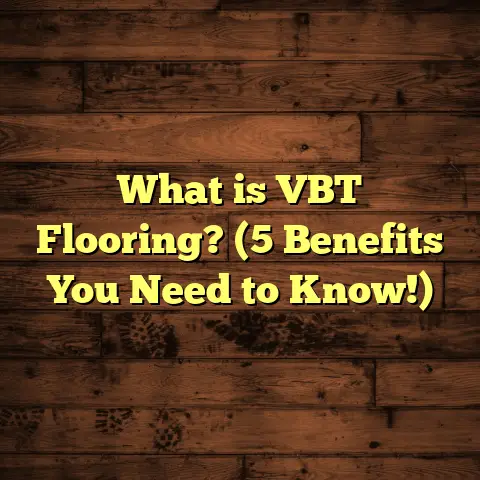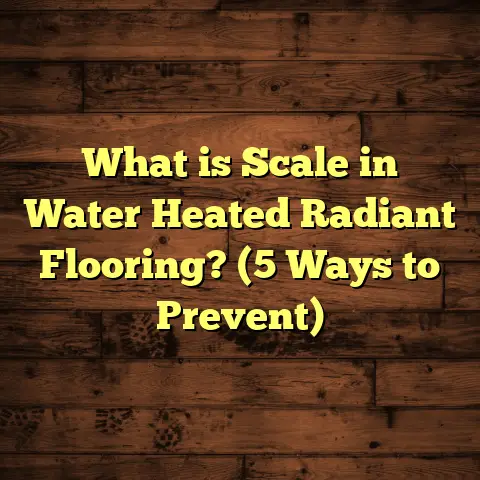What is Engineered Flooring? (5 Benefits for Stylish Homes)
Life is hectic, isn’t it? Between work deadlines, family duties, managing social lives, and squeezing in a little “me time,” home projects often get pushed to the back burner. But when I stopped to think about my own home, I realized that the flooring is one of those things that quietly shapes our daily experience. It’s underfoot every moment — helping define the style, comfort, and even the maintenance routines of our living spaces.
Choosing the right floor feels like a big decision. There’s so many options out there: solid hardwood, laminate, vinyl, tile, carpet… the list goes on. Over the years, I’ve worked with many homeowners and seen firsthand how one option keeps coming up as a favorite for stylish homes — engineered flooring. It combines beauty, practicality, and durability in ways that are hard to beat.
I want to walk you through what engineered flooring is all about, why it works so well in busy homes (like mine and maybe yours), and share some real-life insights from my projects. Along the way, we’ll also compare engineered floors with other popular flooring choices to help you figure out if it’s right for your space.
What Is Engineered Flooring?
When I first heard about engineered flooring years ago, I was curious: how does it differ from solid hardwood? The name itself can be a bit confusing or technical sounding. So let’s break it down simply.
Engineered flooring is made up of multiple layers of wood. The very top layer — called the veneer — is a thin slice of real hardwood. This veneer gives you all the natural grain patterns, colors, and textures you expect from wood floors. It’s what your feet see and feel.
Underneath that hardwood veneer are several layers of plywood or high-density fiberboard (HDF), arranged in a cross-grain pattern. This multi-layered construction forms a stable core that resists the natural expansion and contraction wood undergoes when temperature or humidity changes.
In contrast, solid hardwood flooring consists of single planks made entirely from one piece of wood throughout their thickness. While solid wood has a timeless appeal, it can be more prone to warping or gaps in environments where moisture levels fluctuate.
One thing I learned early on — from both industry training and client feedback — is that engineered floors are designed to keep their shape better in challenging conditions. For example, I installed engineered flooring in a beach house where salt air and humidity swing dramatically throughout the year. Solid hardwood in that setting would have likely cupped or swelled over time; engineered wood stayed flat and beautiful.
The thickness of the top veneer layer varies by product. Higher-end engineered floors might have a 5mm or thicker hardwood layer that allows for sanding and refinishing over the years—almost like solid wood. More budget-friendly options have thinner veneers (around 1-2mm), which still look great but can only be lightly refinished or not at all.
Why Did I Choose Engineered Flooring Myself?
Before diving into details on benefits, I want to share a little about my own flooring journey because it shaped how I think about this material.
When renovating my first home over a decade ago, I initially planned to install solid hardwood throughout the main living areas. But after consulting with suppliers and contractors (including myself at times!), I realized that certain rooms—especially the kitchen and basement—would be risky spots for solid wood due to moisture exposure.
I was drawn to engineered flooring because it promised the natural warmth and texture of hardwood but with better resilience. It also gave me more installation options since my basement had a concrete slab subfloor where nailing down solid wood wasn’t practical.
The final choice was an engineered oak floor with a 4mm thick veneer and plywood core. Installation was done as a floating floor over an underlayment to protect against moisture. The result? Beautiful floors that have held up flawlessly for over 10 years now—with kids running around, pets scratching occasionally, and no significant maintenance beyond regular cleaning.
That experience showed me how engineered flooring offers a balance between style, function, and peace of mind—a balance many homeowners seek but don’t always find in other flooring options.
Five Benefits of Engineered Flooring That Make It Ideal for Stylish Homes
Let’s take a closer look at the key reasons I recommend engineered floors, especially if you want your home to look great without constant worry about upkeep or damage.
1. Superior Stability in Changing Climates
Wood reacts naturally to moisture by expanding or contracting. This can cause problems like gaps between planks, cupping (edges lifting), or buckling (floor lifting off the subfloor).
Engineered flooring’s layered construction counters these effects effectively:
- Cross-layered core: Each plywood or HDF layer is oriented perpendicular to adjacent layers. This cross-grain setup balances out movement forces.
- Reduced expansion: Studies indicate engineered wood expands approximately 40% less than solid hardwood under similar humidity changes.
- Better performance on concrete or radiant heat: Solid hardwood can swell too much on concrete slabs or over radiant heating systems; engineered floors tolerate these environments without damage.
From my work on coastal homes and basements, I’ve seen how this stability translates into long-lasting floors with fewer repairs and refinishing needs. One homeowner told me after two years: “Our engineered floors haven’t shifted a millimeter despite all our rainy season’s humidity swings.”
2. Wide Range of Design Options For Every Style
If you love customizing your home’s look (and who doesn’t?), engineered flooring offers an impressive palette:
- Wood species: Oak, maple, walnut, cherry, hickory — many species come as engineered planks.
- Finishes: Matte, satin, gloss; distressed or smooth textures; colors from bleached whitewash to deep espresso.
- Plank widths: Narrow strips for traditional looks or wide planks for modern rustic vibes.
- Patterns: Some brands offer parquet or herringbone patterns pre-finished.
In one mid-century modern renovation I did last year, we chose engineered Brazilian cherry with a matte finish and wider planks to capture vintage warmth while keeping things sleek.
The availability of styles means you’re not compromising aesthetics when choosing engineered over solid wood. You get authentic grain texture and color because the top veneer is real wood.
3. Installation Flexibility That Saves Time & Money
Installation can be one of the most stressful parts of flooring projects—especially when dealing with uneven subfloors or tricky spaces.
Engineered flooring gives you several options:
- Floating floors: Planks snap together over an underlayment without glue or nails.
- Glue-down: Adhered directly to concrete slabs or wood subfloors.
- Nail-down: Possible on plywood subfloors for certain products.
This flexibility means you can install engineered floors in basements, over radiant heat systems, or on concrete slabs where solid hardwood isn’t suitable.
I remember installing an engineered floor in a condo with radiant heat pipes embedded in the concrete slab below. Solid hardwood would have been risky there due to heat expansion; engineered wood performed perfectly.
Plus, floating installations often cut labor costs since no adhesives or nails are required—something clients appreciate when budgeting.
4. Easier Maintenance Suits Busy Lifestyles
If you’re juggling work deadlines or family schedules like me, ease of care matters.
Engineered floors clean up simply:
- Regular sweeping or vacuuming removes dust and grit.
- Occasional damp mopping with recommended cleaners keeps surfaces fresh.
- Quick wipe-ups prevent stains after spills—especially important with kids or pets around.
Unlike carpet which traps allergens or tile grout that stains easily, engineered wood balances style with practicality.
I’ve advised many families choosing this floor type because it stands up well to everyday wear without needing complex maintenance routines. One client told me: “After switching to engineered floors, I spend way less time worrying about scratches or spills ruining our living room.”
5. Cost-Effective Choice With High-End Appeal
Price is often a big factor when planning home upgrades.
Engineered flooring usually costs less than solid hardwood but offers that same authentic look because of its real wood veneer surface.
Here’s what I’ve found based on recent projects:
| Flooring Type | Material Cost per Sq Ft | Installation Cost per Sq Ft | Total Cost Range (Installed) |
|---|---|---|---|
| Engineered Flooring | $3 – $10 | $2 – $5 | $5 – $15 |
| Solid Hardwood | $5 – $15 | $3 – $6 | $8 – $21 |
The actual price depends on veneer thickness, species choice, and finish quality.
One notable case: A client wanted oak floors throughout a 1,000 sq ft area. Engineered oak came out about 30% cheaper installed than solid oak when factoring all labor and materials—saving them several thousand dollars without losing any style points.
This cost-effectiveness makes engineered wood accessible for many homeowners wanting upscale looks on sensible budgets.
Bonus Benefit: Environmentally Friendly Option
As someone who cares about sustainability (and has seen the impact of deforestation firsthand), I appreciate that engineered flooring uses less slow-growing hardwood per plank compared to solid wood.
Only the thin veneer is real hardwood; layers underneath come from faster-growing timber or recycled wood fiber.
Many manufacturers now source materials from certified sustainable forests (look for FSC certification) and use low-VOC finishes to reduce indoor air pollution.
In eco-conscious projects I’ve handled, specifying certified engineered flooring helped clients meet green building standards while enjoying beautiful floors.
Real Case Studies From My Work
To make this less abstract, let me share a few detailed stories from actual clients who chose engineered flooring:
Case Study 1: Coastal Condo With Humidity Challenges
A couple bought a beach condo with plans to replace old carpet with hardwood feeling floors. They worried about salt air humidity damaging traditional wood.
We picked an engineered teak floor with a plywood core specially treated for moisture resistance. Installation was floating over a vapor barrier membrane.
After three years living there full-time plus frequent vacations away (causing indoor humidity swings), they reported zero warping or surface issues. They loved how natural the teak looked and appreciated no gaps forming seasonally.
Case Study 2: Family Basement Conversion
A family turned their cold concrete basement into a warm rec room. Solid hardwood wasn’t an option due to moisture risk below grade.
Engineered hickory was glued down over a moisture barrier membrane with soundproofing underlayment beneath.
After two winters of heavy use by kids playing and friends over for gatherings, floors remained perfectly flat and scratch-resistant thanks to high-quality finish.
Case Study 3: Urban Loft With Radiant Heat
In a downtown loft renovation featuring radiant floor heating embedded in concrete slabs, we installed wide plank walnut engineered floors designed for heat compatibility.
Digging Deeper: Technical Data & Industry Insights
Here are some data-backed facts that highlight why engineered flooring performs so well:
- Dimensional Stability: According to research by NWFA (National Wood Flooring Association), engineered flooring can reduce moisture-induced expansion by approximately 40% compared to solid hardwood.
- Consumer Preferences: A 2022 Houzz survey found that 67% of homeowners prioritized stability and durability over price when selecting new hardwood floors.
- Market Growth: Engineered flooring sales have grown steadily by around 15% annually in North America since 2020 due to increasing demand for versatile wood flooring.
- Environmental Impact: Lifecycle assessments show that engineered flooring has roughly 25-30% lower environmental footprint related to raw material use compared to equivalent solid hardwood owing to efficient use of veneers and plywood cores.
- Refinishing Life Span: High-end engineered floors with >4mm veneers can be sanded 2-3 times over their lifespan (typically 20+ years), extending longevity close to that of solid hardwood.
How Engineered Flooring Compares With Other Flooring Types
It’s helpful to see how this option stacks up against alternatives you might be considering:
| Feature | Engineered Flooring | Solid Hardwood | Laminate Flooring | Vinyl Plank Flooring | Tile Flooring |
|---|---|---|---|---|---|
| Appearance | Real wood veneer surface | Real wood throughout | Wood look but synthetic base | Varies; some mimic wood well | Wide design variety |
| Stability | High; cross-layered core resists moisture | Lower; vulnerable to warping | Moderate; resists moisture | Very high; waterproof options | Very high; waterproof |
| Installation Options | Floating/glue/nail | Nail down only | Floating | Floating/glue | Mortar & grout |
| Cost Range (Installed) | $5 – $15 / sq ft | $8 – $21 / sq ft | $1 – $5 / sq ft | $2 – $7 / sq ft | $3 – $10 / sq ft |
| Maintenance | Moderate; sweep + mop | Moderate; refinishing possible | Low; easy cleaning | Very low | Low |
| Durability | High; scratch resistant finishes | High; can be refinished | Moderate | High | Very high |
| Environmental Impact | Lower raw material use | High timber demand | Synthetic materials | Synthetic materials | Mixed; natural stone options |
Tips From My Experience When Choosing Engineered Flooring
If you’re leaning toward engineered flooring but wondering how to pick the right product for your home:
- Check veneer thickness: If you want the option to refinish later (great for long-term investment), look for veneers at least 3-4mm thick.
- Consider finish type: Aluminum oxide finishes offer excellent scratch resistance; oil finishes provide warmth but may need more upkeep.
- Match installation method: Confirm your subfloor type—concrete? Radiant heat? Uneven surfaces? Make sure your chosen product supports your installation method.
- Review warranties: Good manufacturers back their products with warranties covering wear layer durability and structural integrity.
- Source sustainably: Look for FSC or other credible certifications if environmental impact matters to you.
I always spend time discussing these factors with clients before ordering materials—it saves headaches later!
Final Thoughts On Engineered Flooring For Stylish Homes
So where does this leave us? If you want floors that combine:
- The natural beauty of real hardwood,
- Stability in rooms prone to moisture changes,
- Flexibility in installation,
- Easier maintenance,
- And cost efficiency,
then engineered flooring deserves serious consideration.
Compared to solid hardwood: Engineered offers better performance in challenging environments at lower cost with more installation options—though sanding opportunities depend on veneer thickness.
Compared to laminate or vinyl: Engineered provides authentic wood texture and warmth rather than synthetic appearance but usually costs more upfront.
Compared to tile: Engineered gives warmth underfoot but lacks tile’s waterproof durability—so think about room function carefully (bathrooms might favor tile).
Personally, after working on dozens of projects across various climates and home styles, I find engineered flooring hits a sweet spot for many homeowners wanting stylish yet practical floors they can enjoy day after day without stress.
What questions do you have about making this choice? Or maybe there’s a tricky space in your home you want advice on? I’m here to help you figure out what fits best so your floors stay beautiful through all life’s ups and downs.





